Manufacturer of analog chips, Analog Devices (NASDAQ:ADI) reported results in line with analysts' expectations in Q1 FY2024, with revenue down 22.7% year on year to $2.51 billion. On the other hand, next quarter's revenue guidance of $2.1 billion was less impressive, coming in 10.9% below analysts' estimates. It made a non-GAAP profit of $1.73 per share, down from its profit of $2.75 per share in the same quarter last year.
Analog Devices (ADI) Q1 FY2024 Highlights:
- Revenue: $2.51 billion vs analyst estimates of $2.50 billion (small beat)
- EPS (non-GAAP): $1.73 vs analyst estimates of $1.71 (1.4% beat)
- Revenue Guidance for Q2 2024 is $2.1 billion at the midpoint, below analyst estimates of $2.36 billion
- Free Cash Flow of $915.9 million, up 28.8% from the previous quarter
- Inventory Days Outstanding: 136, down from 140 in the previous quarter
- Gross Margin (GAAP): 58.7%, down from 65.4% in the same quarter last year
- Market Capitalization: $93.91 billion
Founded by two MIT graduates, Ray Stata and Matthew Lorber in 1965, Analog Devices (NASDAQ:ADI) is one of the largest providers of high performance analog integrated circuits used mainly in industrial end markets, along with communications, autos, and consumer devices.
ADI is one of the largest analog chip makers, and is a major supplier of converters, amplifiers, sensors, and digital signal processing chips used by over hundred thousand customers.
ADI has been an active consolidator in the space, acquiring Hittite Microwave in 2014 which added radio frequency or RF chips to its portfolio, Linear Technology in 2017 which bolstered ADI’s power management chips. In 2021 it closed its $21 billion acquisition of Maxim Integrated, which increased ADI’s exposure to faster growing automotive and data center end markets.
Analog Devices’ peers and competitors include Texas Instruments (NASDAQ: TXN), Skyworks (NASDAQ:SWKS), Infineon (XTRA:IFX), NXP Semiconductors NV (NASDAQ:NXPI), ON Semi (NASDAQ:ON), Marvell Technology (NASDAQ:MRVL), and Microchip (NASDAQ:MCHP).Analog Semiconductors
Longer manufacturing duration allows analog chip makers to generate greater efficiencies, leading to structurally higher gross margins than their fabless digital peers. The downside of vertical integration is that cyclicality can be more pronounced for analog chipmakers, as capacity utilization upsides work in reverse during down periods.
Sales Growth
Analog Devices's revenue growth over the last three years has been strong, averaging 29.8% annually. But as you can see below, its revenue declined from $3.25 billion in the same quarter last year to $2.51 billion. Semiconductors are a cyclical industry, and long-term investors should be prepared for periods of high growth followed by periods of revenue contractions (which can sometimes offer opportune times to buy).
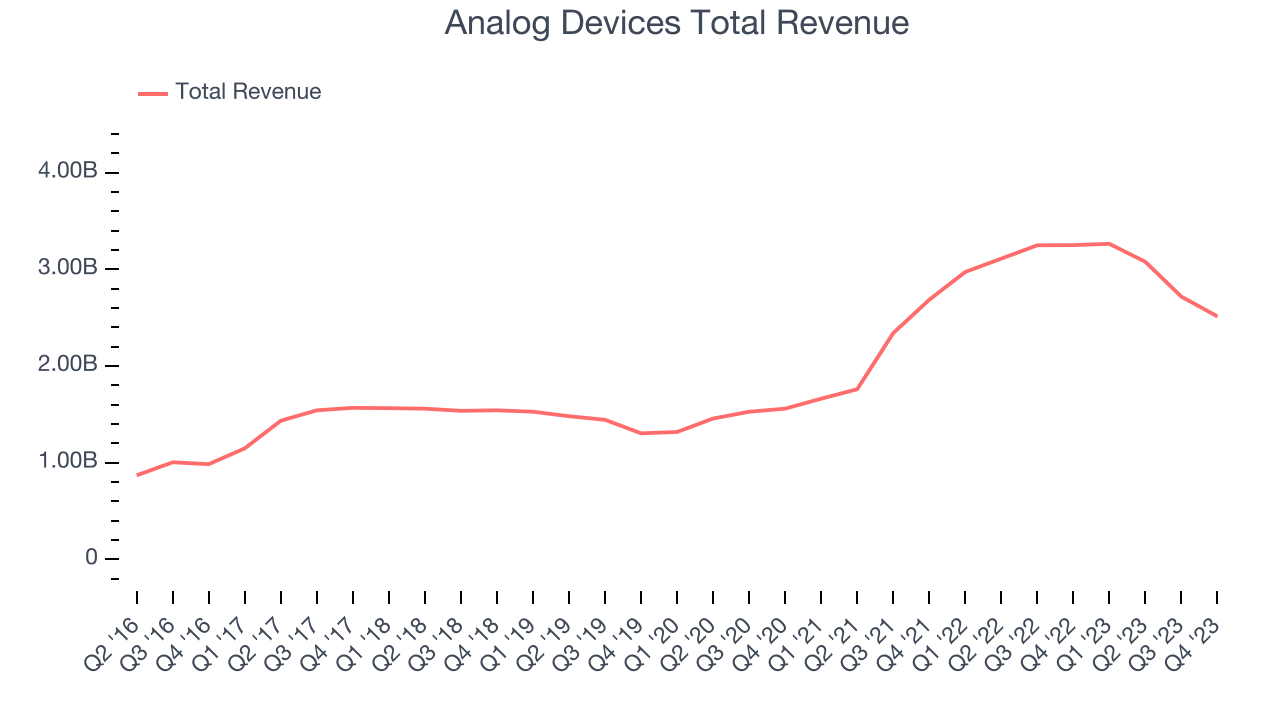
This was a slow quarter for the company as its revenue dropped 22.7% year on year, in line with analysts' estimates. This could mean that the current downcycle is deepening.
Analog Devices's revenue growth has decelerated over the last three quarters and its management team projects revenue to fall next quarter. As such, the company is guiding for a 35.6% year-on-year revenue decline while analysts are expecting a 11.7% drop over the next 12 months.
Product Demand & Outstanding Inventory
Days Inventory Outstanding (DIO) is an important metric for chipmakers, as it reflects a business' capital intensity and the cyclical nature of semiconductor supply and demand. In a tight supply environment, inventories tend to be stable, allowing chipmakers to exert pricing power. Steadily increasing DIO can be a warning sign that demand is weak, and if inventories continue to rise, the company may have to downsize production.
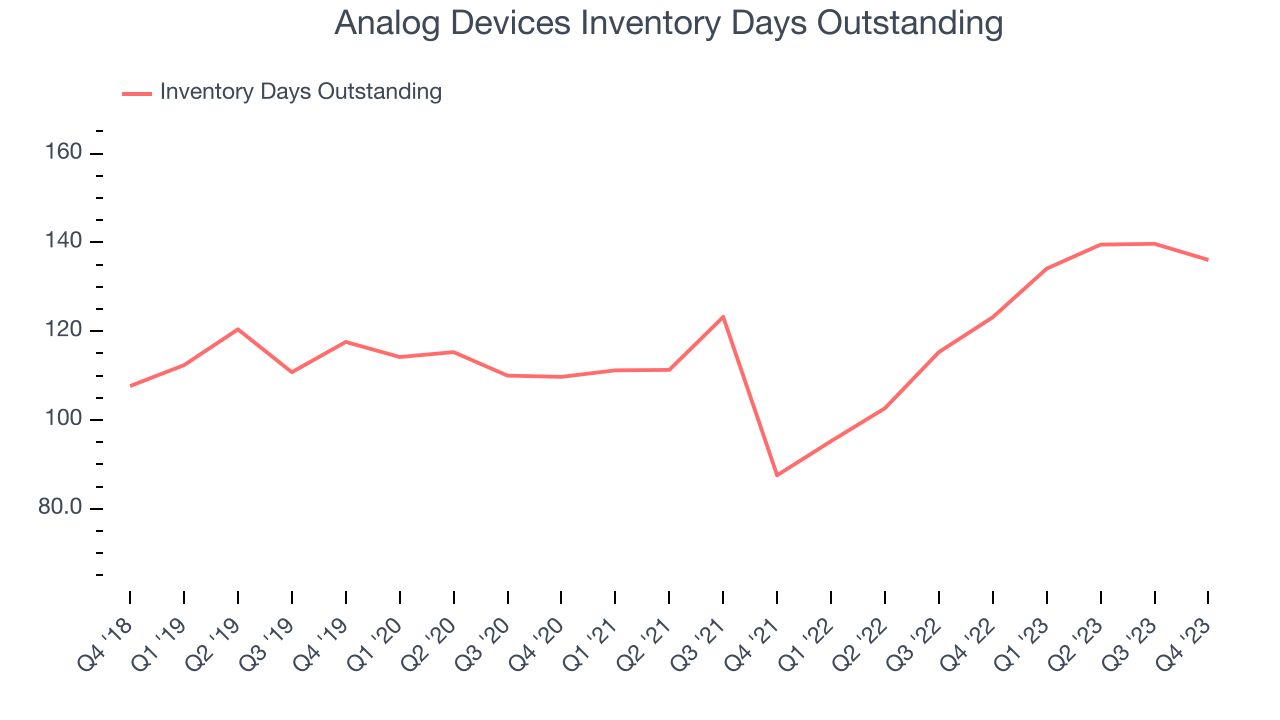
This quarter, Analog Devices's DIO came in at 136, which is 20 days above its five-year average. These numbers suggest that despite the recent decrease, the company's inventory levels are higher than what we've seen in the past.
Pricing Power
In the semiconductor industry, a company's gross profit margin is a critical metric to track because it sheds light on its pricing power, complexity of products, and ability to procure raw materials, equipment, and labor. Analog Devices's gross profit margin, which shows how much money the company gets to keep after paying key materials, input, and manufacturing costs, came in at 58.7% in Q1, down 6.7 percentage points year on year.
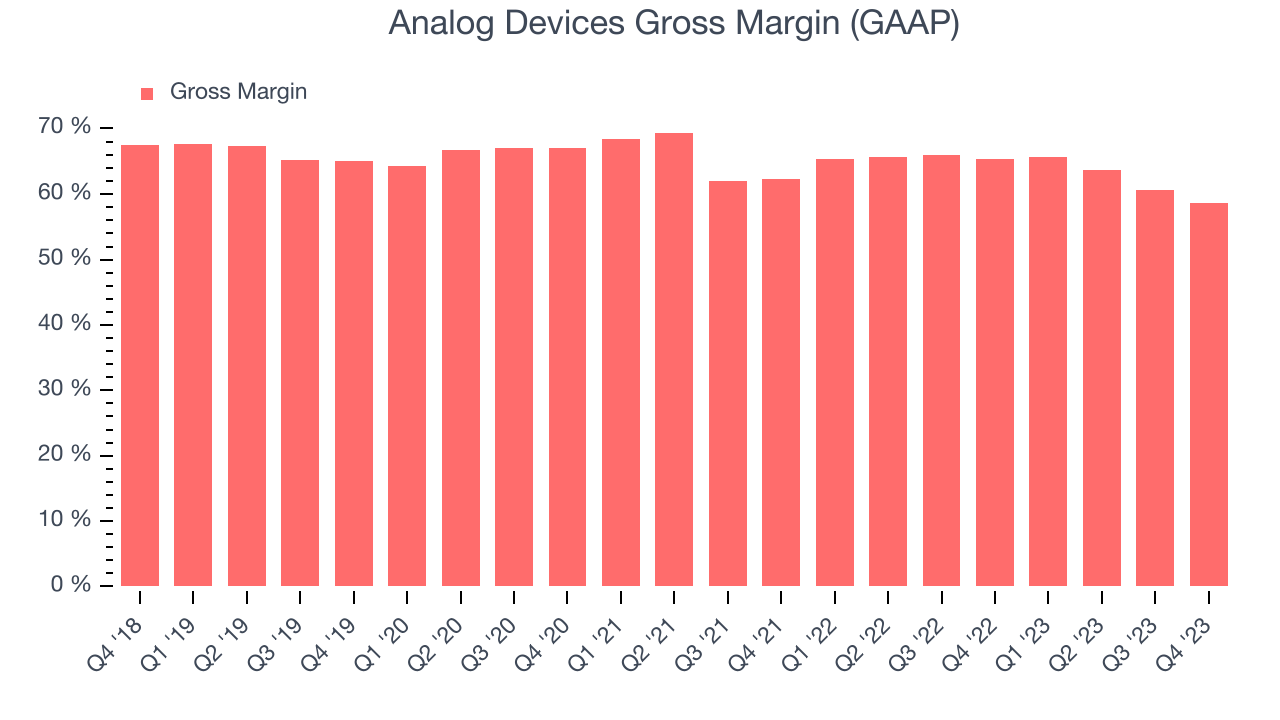
Despite declining over the past year, Analog Devices still retains robust gross margins, averaging 62.5%. These attractive unit economics point to its potent and competitive product offering, pricing power, and efficient inventory management.
Profitability
Analog Devices reported an operating margin of 42% in Q1, down 9.1 percentage points year on year. Operating margins are one of the best measures of profitability because they tell us how much money a company takes home after manufacturing its products, marketing and selling them, and, importantly, keeping them relevant through research and development.
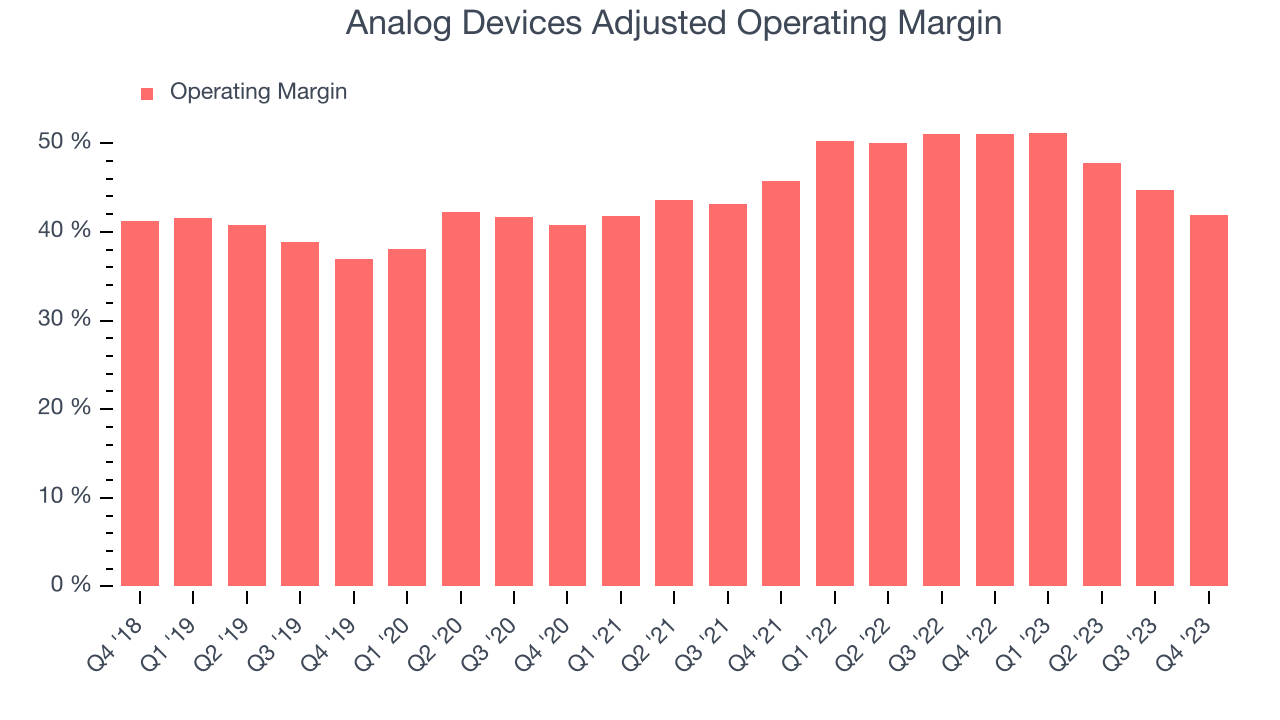
Analog Devices's operating margins have been trending down over the last year, averaging 46.8%. However, the company's profitability remains one of the highest in the industry, driven by its strong gross margins and economies of scale generated from its highly efficient operating model.
Earnings, Cash & Competitive Moat
Wall Street expects earnings per share to decline 16.8% over the next 12 months, although estimates will likely change after earnings.
Although earnings are important, we believe cash is king because you can't use accounting profits to pay the bills. Analog Devices's free cash flow came in at $915.9 million in Q1, down 25.5% year on year.
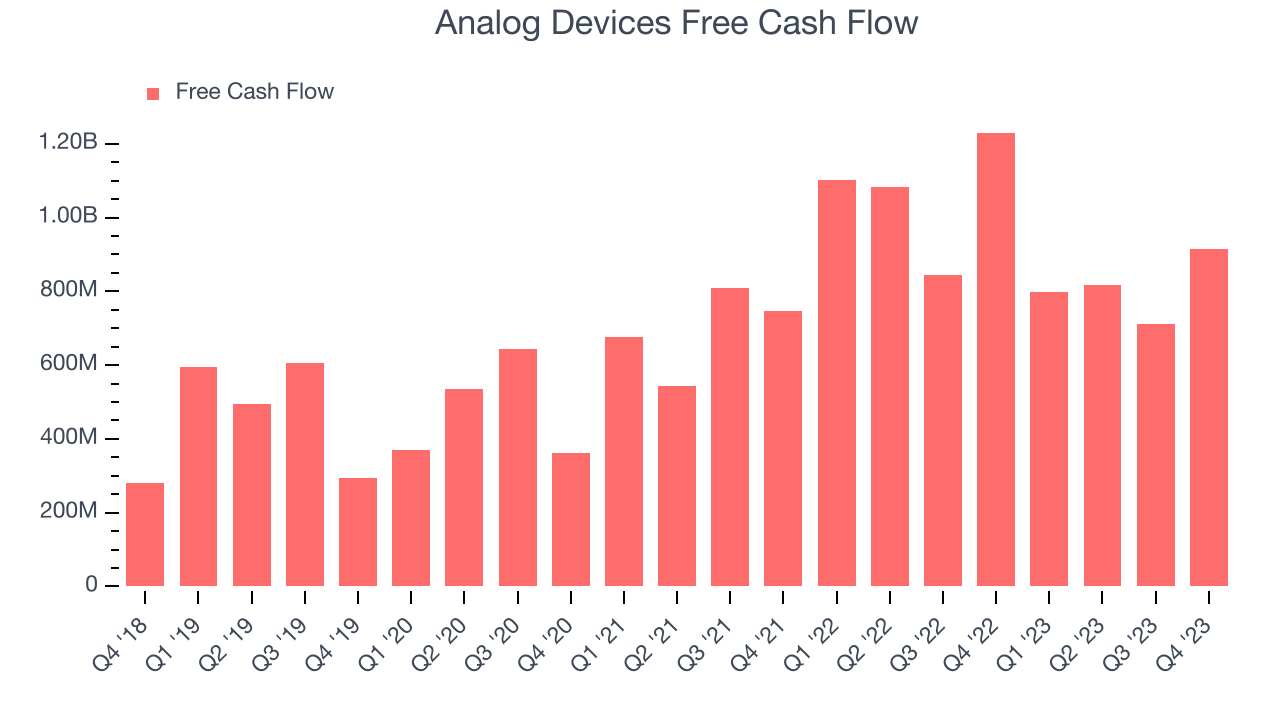
As you can see above, Analog Devices produced $3.24 billion in free cash flow over the last 12 months, an eye-popping 28% of revenue. This is a great result; Analog Devices's free cash flow conversion places it among the best semiconductor companies and, if sustainable, puts the company in an advantageous position to invest in new products while remaining resilient during industry downturns.
Return on Invested Capital (ROIC)
EPS and free cash flow tell us whether a company was profitable while growing revenue. But was it capital-efficient? Enter ROIC, a metric showing how much operating profit a company generates relative to how much money the business raised (debt and equity).
Analog Devices's five-year average ROIC was 7.8%, somewhat low compared to the best semiconductor companies that consistently pump out 35%+. Its returns suggest it historically did a subpar job investing in profitable business initiatives.
The trend in its ROIC, however, is often what surprises the market and drives the stock price. Unfortunately, Analog Devices's ROIC over the last two years averaged a 1.9 percentage point decrease each year. In conjunction with its already low returns, these declines suggest the company's profitable business opportunities are few and far between.
Key Takeaways from Analog Devices's Q1 Results
It was encouraging to see Analog Devices beat analysts' revenue and EPS expectations this quarter, driven by better-than-expected performance in its automotive end market ($739 million of revenue vs estimates of $708 million). That result (+9% year-on-year growth for auto) was especially encouraging given the pessimism surrounding the auto sector to begin 2024. We were also glad the company's inventory levels shrunk.
On the other hand, Analog Devices's revenue guidance for next quarter missed analysts' expectations and its gross margin shrunk. It does, however, expect demand to pick back up in the second half of 2024 with management stating:
"We expect customer inventory rationalization to largely subside in our second quarter, and thus enter the second half in a more favorable business backdrop."
Lastly, the Board declared a quarterly cash dividend of $0.92 per outstanding share of common stock. The dividend will be paid on March 15, 2024 to all shareholders of record on March 5, 2024.
Overall, this was a mixed quarter for Analog Devices. The company is down 2.3% on the results and currently trades at $185.15 per share.
Is Now The Time?
Analog Devices may have had a bad quarter, but investors should also consider its valuation and business qualities when assessing the investment opportunity.
Although we have other favorites, we understand the arguments that Analog Devices isn't a bad business. Its impressive revenue growth over the last three years suggests it's increasing its market share, and growth is expected to increase in the short term. And while its relatively low ROIC suggests it has struggled to grow profits historically, the good news is its powerful free cash generation enables it to sustainably invest in growth initiatives while maintaining an ample cash cushion.
Analog Devices's price-to-earnings ratio based on the next 12 months is 26.5x. We don't really see a big opportunity in the stock at the moment, but in the end beauty is in the eye of the beholder. And if you like the company, it seems that Analog Devices doesn't trade at a completely unreasonable price point.
Wall Street analysts covering the company had a one-year price target of $207.04 per share right before these results (compared to the current share price of $185.15).
To get the best start with StockStory check out our most recent Stock picks, and then sign up to our earnings alerts by adding companies to your watchlist here. We typically have the quarterly earnings results analyzed within seconds of the data being released, and especially for the companies reporting pre-market, this often gives investors the chance to react to the results before the market has fully absorbed the information.
